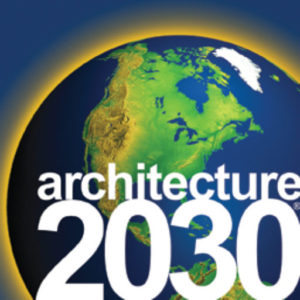Accelerating the 2030 Challenge to 2021
July 2021 | Thought Leadership
Architecture 2030’s namesake target year to achieve carbon-neutral buildings is now deemed too late by CEO and founder Edward Mazria and COO Vincent Martinez.
In 2005, Architecture 2030 issued the 2030 Challenge. The initiative comprised incremental carbon-reduction goals over a 25-year timeline that were consistent with those called for by the global scientific community at the time. Meeting the targets would mean that all new buildings and major renovations would be carbon neutral by 2030. That is, the projects would use no on-site fossil fuels, including natural gas or heating oil; instead, they would be 100% powered by on-site and/or off-site renewable energy.
However, current data from the scientific community has made it clear that 2030 is too late. To meet the 1.5°C carbon budget, all new buildings and major renovations must be designed to be carbon neutral today.
The Significance of a Half Degree
The 2015 Paris Agreement established the goal of keeping planetary warming to below 2˚C while pursuing efforts to limit it to 1.5°C. Since then, the world has been quickly depleting this 1.5˚C carbon budget.
Limiting planetary warming to 1.5˚C rather than 2˚C is critical. That 0.5˚C difference in warming means that 1.7 billion more people will be exposed to severe heat waves every five years; 100 to 400 million more people will be at risk of hunger; and 1 to 2 billion more people will no longer have adequate water. The world can also expect more extreme droughts, precipitation, flooding, and vector-borne diseases, among other catastrophic effects.
The Future Is Here
In its strongest warning yet, the International Energy Agency called for the world to stop all new gas, oil, and coal development this year in order to have a chance at meeting the Paris Agreement 1.5˚C limit. For that to happen, we need an immediate and fundamental global shift in the way we plan and design the built environment.
For architects, engineers, and planners (AEP), this means designing and renovating buildings and developments to operate with only renewable energy produced on-site and/or procured off-site. No on-site fossil fuels are allowed.
Achieving carbon-neutral new buildings today is not as difficult as it may have once seemed. The knowledge and technology are available in all climates, and the health, economic, and environmental benefits are well documented. Carbon-neutral buildings are even supported by current building energy codes—namely the national and international ZERO Code (ASHRAE 90.1-2019) and the 2021 International Energy Conservation Code. Both yield highly efficient buildings that, when coupled with renewable energy for building operations, result in zero CO2 emissions.
The global AEP community has an extraordinary opportunity to lead efforts on mitigating climate change. It is, in short, the ultimate design project for the common good.
This article was originally published in ARCHITECT magazine on July 02, 2021.




